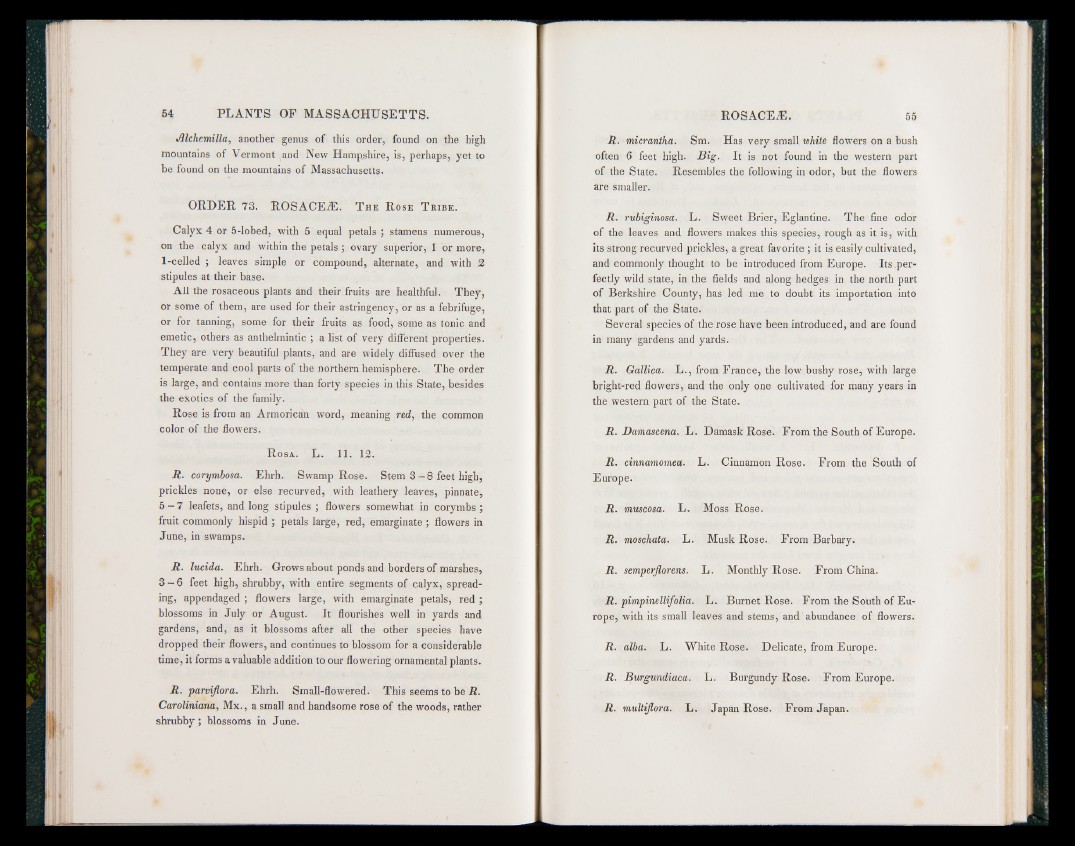
Jllchemilla, another genus of this order, found on the high
mountains of Vermont and New Hampshire, is, perhaps, yet to
be found on the mountains of Massachusetts.
ORDER 73. ROSACEiE. T h e R ose T r ib e .
Calyx 4 or 5-lobed, with 5 equal petals ; stamens numerous,
on the calyx and within the petals ; ovary superior, 1 or more,
1-celled ; leaves simple or compound, alternate, and with 2
stipules at their base.
All the rosaceous plants and their fruits are healthful. They,
or some of them, are used for their astringency, or as a febrifuge,
or for tanning, some for their fruits as food, some as tonic and
emetic, others as anthelmintic ; a list of very different properties.
They are very beautiful plants, and are widely diffused over the
temperate and cool parts of the northern hemisphere. The order
is large, and contains more than forty species in this State, besides
the exotics of the family.
Rose is from an Armorican word, meaning red, the common
color of the flowers.
R osa. L. 11. 12.
R. corymbosa. Ehrh. Swamp Rose. Stem 3 - 8 feet high,
prickles none, or else recurved, with leathery leaves, pinnate,
5 — 7 leafets, and long stipules ; flowers somewhat in corymbs ;
fruit commonly hispid ; petals large, red, emarginate •, flowers in
June, in swamps.
R. lucida. Ehrh. Grows about ponds and borders of marshes,
3 - 6 feet high, shrubby, with entire segments of calyx, spreading,
appendaged ; flowers large, with emarginate petals, red ;
blossoms in July or August. It flourishes well in yards and
gardens, and, as it blossoms after all the other species have
dropped their flowers, and continues to blossom for a considerable
time, it forms a valuable addition to our flowering ornamental plants.
R. parviflora. Ehrh. Small-flowered. This seems to be R.
Caroliniana, Mx., a small and handsome rose of the woods, rather
shrubby ; blossoms in June.
R. micrantha. Sm. Has very small ichite flowers on a bush
often 6 feet high. Big. It is not found in the western part
of the State. Resembles the following in odor, but the flowers
are smaller.
R. rubiginosa. L. Sweet Brier, Eglantine. The fine odor
of the leaves and flowers makes this species, rough as it is, with
its strong recurved prickles, a great favorite ; it is easily cultivated,
and commonly thought to be introduced from Europe. Its .perfectly
wild state, in the fields and along hedges in the north part
of Berkshire County, has led me to doubt its importation into
that part of the State.
Several species of the rose have been introduced, and are found
in many gardens and yards.
R. Gallica. L ., from France, the low bushy rose, with large
bright-red flowers, and the only one cultivated for many years in
the western part of the State.
R. Bamascena. L. Damask Rose. From the South of Europe.
R. cinnamomea. L. Cinnamon Rose. From the South of
Europe.
R. muscosa. L. Moss Rose.
R. moschata. L. Musk Rose. From Barbary.
R. semperflorens. L. Monthly Rose. From China.
R. pimpinellifolia. L. Burnet Rose. From the South of Europe,
with its small leaves and stems, and abundance of flowers.
R. alba. L. White Rose. Delicate, from Europe.
R. Burgundiaca. L. Burgundy Rose. From Europe.
R. multijlora. L. Japan Rose. From Japan.